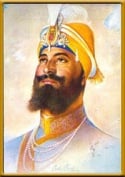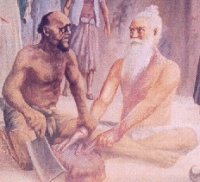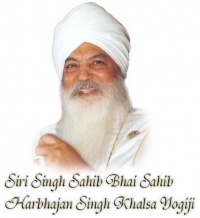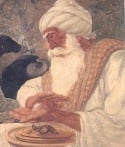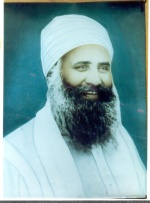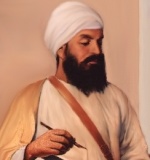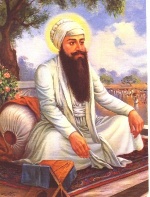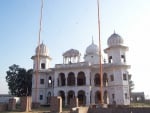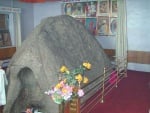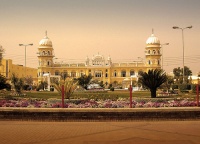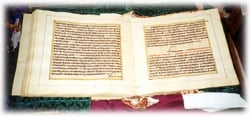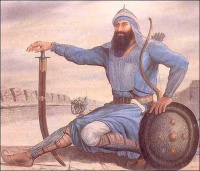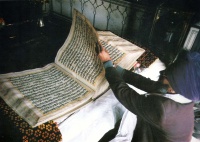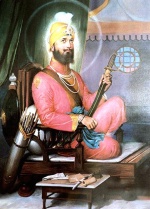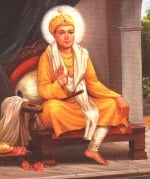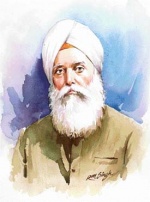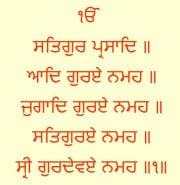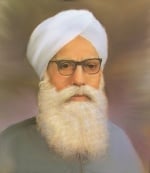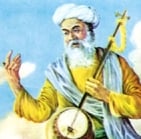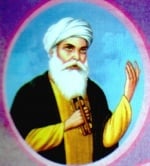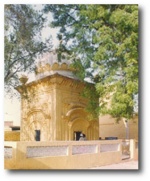SikhiWiki:Today's featured article/October 2009
Today's featured article archive
2007 -
2008 -
2009 -
2010 -
January - February - March - April - May - June - July - August - September - October - November - December
Today is Saturday, April 20, 2024; it is now 14:43 UTC
Featured content:
| << | Today's featured articles for October 2009 | >> | ||||
| Su | Mo | Tu | We | Th | Fr | Sa |
| 1 | 2 | 3 | ||||
| 4 | 5 | 6 | 7 | 8 | 9 | 10 |
| 11 | 12 | 13 | 14 | 15 | 16 | 17 |
| 18 | 19 | 20 | 21 | 22 | 23 | 24 |
| 25 | 26 | 27 | 28 | 29 | 30 | 31 |
- October 1
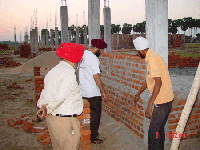
Seva is the essence of Sikhism. If there is one solitary word to sum up the Sikh religion, I would unhesitatingly pick seva as the operative word.
Seva is the voluntary service to fellow beings without any expectation of reciprocation. It is deeply ingrained in the collective psyche of the Sikhs.
Seva is what shines in Sikhism above all. I can say it without any exaggeration or the fear of contradiction that the extent of seva that is found among the Sikhs is rarely found in any other religion. The accent is upon the word, `Voluntary'. That makes the Sikhs unique.
It has often been seen in India that whenever there is any natural calamity on a large scale, the Sikh organizations are the first to reach there to provide succour to the affected people. After the devastating earth-quake in Katchh in the Gujarat State of India in 2001, the Sikhs had put up some of the biggest camps to provide free food to the quake-affected people. .....More
view – talk – edit – history
- October 2
Guru Gobind Singh in the Dasam Granth in verse number 9 of Tav Prasad Saviaye puts a seal on the concept of Love leading to salvation.
Tav Prasad Saviaye is one of the five Banis of a Sikh's daily Nitnem routine of reciting of the Guru's words.
In this Bani (Guru's composition), the tenth master covers many aspects of human living which one needs to inspect on a daily basic but the central message is the concept of "Love for the Lord and his creation" and the "constant remembrance of His Name".
If you do not feel any love for God; you will not feel any love for His creation and vice versa; your heart will be barren and you will have no compassion or mercy. The Guru reminds us:
| ਸਾਚੁ ਕਹੋਂ ਸੁਨ ਲੇਹੁ ਸਭੈ ਜਿਨ ਪ੍ਰੇਮ ਕੀਓ ਤਿਨ ਹੀ ਪ੍ਰਭ ਪਾਇਓ ॥੯॥ |
| Sach kahon sun leho sabai jin prem kio tin hee prabh paio. |
| I tell the truth; listen everyone. Only those who have Loved, will realize the Lord. (9) |
The message of Love and longing is evident on all the pages of the Sikh scriptures. The Love for God and His creation is easy to see in Gurbani; the Lord is referred to as "Husband Lord", "Beloved", "Immaculate", "Great", "Merciful", etc. all affectionate words for a tender, caring and powerful being. .....More
view – talk – edit – history
- October 3
Bhai Mani Singh "Shaheed" (martyr) (1670 - 9 July 1737), was a great Sikh personality of the eighteenth century; he occupies a very esteemed position in Sikh history as he assumed control and steered the course of destiny of the Sikh panth at a very critical stage.
A great scholar, a devoted Sikh, and a courageous leader, Bhai Mani Singh willingly laid down his life to uphold the dignity of the Sikh faith and Sikh principles. Due to the nature of his martyrdom, his actions have become a part of the daily Sikh Ardas (prayer) of the Sikhs.
He is said to have been brought in the early years of his childhood to the presence of Guru Tegh Bahadur at Anandpur. He was not the same age as the Guru's own son, Gobind Rai; however they became close friends.
Bhai Mani Singh remained in his company even after he had ascended the religious seat as Guru in 1675. Mani Singh accompanied the Guru to the seclusion of Paonta sahib where Guru Gobind Singh spent some three years in large part given to literary work. .....More
view – talk – edit – history
- October 4
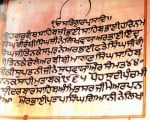
The editorial pattern of Guru Granth Sahib is the gift of the illustrious Guru Arjun Dev. The current volume of the Granth (total pages 1430) follows in the main the editorial scheme set by the Fifth Guru, with addition of Guru Tegh Bahadur’s Bani-compositions including his verses in Raag Jaijavanti.
The first recension popularly known as the Adi-Granth comprised three broad divisions: (a) the liturgical section with prayers of daily routine; (b) the musical section that is by far the largest part (1340 pages of the present edition); (c) the miscellaneous part of compositions which are not set to Raag measures but dwell on various poetical metres.
The contributors of the Granth include six Gurus, 15 Bhagats, 12 Bards (Bhatts) plus one Dum, a couple of associates of the Gurus, making a total of 36 authors.
The verses composed by eleven Bhatts in the Swayya metre are to be found in the Miscellaneous division of the holy Granth, which starts with Sahaskriti Saloks, followed by Gatha, Phunhas, Chaubolas and Saloks of Bhagat Kabir and Shiekh Farid. .....More
view – talk – edit – history
- October 5
Harbhajan Singh Khalsa Yogiji (born as Harbhajan Singh Puri) (August 26, 1929 - October 6, 2004), also known as Yogi Bhajan and Siri Singh Sahib, was a charismatic and influential proponent of Kundalini Yoga and the Sikh Dharma.
He is best known as the spiritual director of the 3HO (Healthy, Happy, Holy Organization) Foundation, which today is one of the world's largest yoga-teaching bodies, and for his outspoken defense of the holistic doctrine of Sikh teachings.
Widely known as a master of Kundalini Yoga, he taught thousands of his students to be teachers and to spread his teachings.
Harbhajan Singh was born on August 26, 1929 into a Sikh family in Kot Harkarn, district Gujranwala, in the province of Punjab (British India). His father, Dr. Kartar Singh Puri, served the British Raj as a medical doctor. His mother was named Harkrishan Kaur. Theirs was a well-to-do landlord family, owning most of their village in the foothills of the Himalayas. .....More
view – talk – edit – history
- October 6
Baba Buddha ji (6 October 1506 - 8 September 1631), one of the most venerated, primal figures of early Sikhism, was born on 6 October 1506 at the village of Katthu Nangal, 18 km north east of Amritsar.
After sometime the family settled down in Dhalla village not far away from river Ravi opposite Kartarpur. Bura, as he was originally named, was the only son of Bhai Suggha, a Jatt of Randhava clan, and Mai Gauran, born into a Sandhu family.
Bhai Budha occupies a unique position in Sikh history. He applied the tilak of guruship to five Gurus, saw seven Gurus and remained in close association with first six Sikh Gurus from 1521 to 1631 for over one hundred years. He was the first priest of Harimandir Sahib, and laid the foundations of Dera Baba Nanak and most of the holy buildings at Amritsar.
As a small boy, he was one day grazing cattle outside the village when, in 1524 A.D, Guru Nanak happened to pass by his village. According to Bhai Mani Singh, Sikhan di Bhagat Mala, Bura went up to him and, making obeisance with a bowl of milk as his offering, .....More
view – talk – edit – history
- October 7
Baba Ishar Singh Ji (26 March 1913 - 7 October 1963) (Born Inder Singh ) was the son of S. Bagga Singh and Mata Partap Kaur. He was born on the 26 March 1913 (13th Chet) at the Village of Jhoraran, District Ludhiana (Punjab, India) He died on the 7 October 1963 at the age of 50 years.
Inder Singh (his childhood name) had four brothers and two sisters. Even as a child he was very soft spoken, of a kind temperament and a very helpful attitude to others. He was very fond of listening to the historical accounts of the lives of the Sikh Gurus and the stories of the lives of saintly and divine people.
That is why, perhaps, even at a young age he never liked to indulge in any 'trivial' playing or simple games that most children are fond of. Instead of jumping and indulging in playing around with boys of his age, he would rather spend time meditating on the formless god, in a secluded and quiet place. .....More
view – talk – edit – history
- October 8
Bhai Santokh Singh, (1787 - 1843) the noted author of six important literary works - Naam Kosh, Guru Nanak Parkash, Garb Ganjni Teeka, Balmik Ramayan, Atam Purayan Teeka and his magnum opus, Sri Gur Partap Suraj Granth aka Suraj Parkash, was born on 8 October 1787.
He was the son of Bhai Deva Singh and Mata Rajadi, professional cloth printers of Nurdin village, also known as Sarai Nurdin, 7 km northwest of Tarn Taran in Amritsar district of the Punjab, India.
His father, though poor, was educated and well versed in the sacred texts. He sent his son, after preliminary education at home, to Amritsar where he became a pupil of Giani Sant Singh (1768 - 1832), a renowned man of letters and custodian of Sri Darbar Sahib.
After having studied Sikh Scripture and history, Sanskrit language and literature, poetics, philosophy and mythology at Amritsar for about 15 years, Santokh Singh moved to Buna, an old town on the right bank of the Yamuna in the present Yamuna Nagar district of Haryana, some time before 1813.
There he established himself as a writer, poet, and preacher. .....More
view – talk – edit – history
- October 9
On October 9 every year, the worldwide Sikh community celebrates the birth of their fourth master, Guru Ram Das.
Guru ji was born at Chuna Mandi Bazaar, Lahore at the site of the present holy shrine on 9 October, 1534 where he spent his first seven years of life. Soon after birth, he was given the name "Jetha", meaning the "first born".
His simple and God-fearing parents, Hari Das and Anup Devi of Lahore were delighted at this precious gift from Waheguru. As he was growing up and in his teens, he would be found in the company of religious men. Jetha became a handsome young man.
One day he came across a party of Sikhs who were on their way to Goindwal to pay homage to Guru Amar Das ji, the third Sikh Guru. He decided to join them and also travel to Goindwal. Upon their arrival and meeting, Guru Amar Das, the third Sikh Guru at once noticed the young Jetha with his pleasant manner and sense of devotion.
While his fellow travellers returned to Lahore, Jetha decided to stay and become a disciple of Guru Amar Das ji. .....More
view – talk – edit – history
- October 10
The Battle of Hargobindpur was, the second battle in which Guru Hargobind and his Sikh Risaldari (comrades), fought the forces of Abdullah Khan the Mughal governor, (Subedar) of Jalandhar.
This historic war happened in September 1629 (according to some chronicles 1628).
The battle was fought near the village of Ruhela where Guru Hargobind and his warriors defeated the Mughal force commanded by Turkish chieftains and the governor Abdullah Khan.
After the victory the area in which the battle was fought became the town of Sri Hargobindpur.
Much earlier a new village called Hargobindpur had been established near the village of Ruhela, on the bank of the Beas river by Guru Arjan Dev.
The fifth Guru named this new village in honour of his young son Hargobind. However, after the arrest, torture and martyrdom of Guru Arjun Dev, the area fell under the control of Diwan Chandu Lal, an influential Hindu banker and chief minister of Emperor Jahangir. .....More
view – talk – edit – history
- October 11
In 1986-87, I was posted as a Major, at an army outpost in the village of Segang-Menchukha, in the north western corner of West Siang District of Arunachal Pradesh, India.
One night I was woken up in the middle of the night by loud and persistent knocking at my door. “Who could it be at this time?” I wondered.
When I opened the door, I found it to be the village headman, locally known as 'Gaon Burha'. He was in an obvious state of distress and told me that his son was dying of a severe pain in his stomach and asked if I would send for a doctor.
I considered it fit to check the patient myself before I telephoned the doctor, who was some distance away and the track was quite hazardous. I decided to accompany Gaon Burha.
He led me to his wooden hut, which was divided into two, the portion in front was for cooking and at the rear was the living room where I found a young boy writhing in pain and crying.
As a precautionary measure, I had taken some pain-killing and Digene tablets with me, which I offered to the sick boy. .....More
view – talk – edit – history
- October 12
Gurdwara Janam Asthaan is the shrine representing the home of Mehta Kalyan Dass and Mata Tripta, the father and mother respectively of Guru Nanak Dev, founder of Sikhism.
This is the location of the home where the founder Guru was born; the original shrine was established by Baba Dharam Chand (1523-1618) son of Baba Lakhmi Das and grandson of Guru Nanak Dev.
The shrine is located in the holy city of Nankana Sahib, West Punjab, Pakistan.
The shrine must have been established before the end of the sixteenth century because Guru Arjan Dev (1563-1606) is believed to have visited it. Its present building comprising a square, domed sanctum with a rectangular pavilion attached to it within a vast walled compound was built by Maharaja Ranjit Singh.
It is believed that a room was first built here by the Guru's son, Baba Lakhmi Das (1497-1555) but it is more probably that this was built by his grandson, Baba Dharam Chand (1523-1618). The initial building was known as "Kalu ka Kotha", literally meaning the "house of (Mehta) Kalu", father of Guru Nanak. Later it came to be known as "Nanakayan", literally "home of (Guru) Nanak". .....More
view – talk – edit – history
- October 13
Bichitra Natak (or Bachittar/Vichitra) (Gurmukhi ਬਚਿਤਰ ਨਾਟਕ meaning "Wonderful Drama") is the autobiography of Guru Gobind Singh, the 10th Sikh Guru.
It is a part of the Dasam Granth and is the name given to the third Bani in the second holy scriptures of the Sikhs. This text spans from page 94 to page 175 of the 2326 pages of this holy book of the Sikhs at www.srigranth.org. (Original text is over 1428 pages)
This Bani is an autobiographical narrated by the tenth Sikh Guru, Guru Gobind Singh for the first 32 years of his life. Although the word "Natak" means "drama" in Punjabi, this is no drama. The Guru has outlined the circumstance and history of the time and how great courage and strength was required to overcome the many hurdles that were upon the community.
It starts with a praise of Akal Purakh and then gives a genealogy of Bedis and Sodhis starting from Lord Rama and his two sons. Then comes the author's own biography and includes the battle of Nadaun, Husaini battle and the arrival of Prince Muazzam in the Punjab. It continues the ancient history until 1696 AD. .....More
view – talk – edit – history
- October 14
The word "Sikhism" is derived from "Sikh", which is a Punjabi word that means a "dedicated" and "devoted" disciple or student. It is estimated that there are about 25 million Sikhs worldwide, making Sikhism or Sikhi, the 5th largest religion in the world.
Of these 25 million Sikhs, approximately 20 million Sikhs live in India, primarily in the state of Punjab in the north west part of the sub-continent. Outside the Punjab, large populations of Sikhs can also be found in the United Kingdom, Canada, and the United States. Sikhs are a significant minority in Malaysia, Singapore and Australia. In most of the foreign countries, they have faced hardships because of their appearance but are respected for their hard work and skills.
Sikhism was founded by Guru Nanak, who was born in 1469. Nine other Gurus followed him from 1539 to 1708. The Gurus preached the same message to all the peoples of the world. They urged people of all religions or of no religion to work together in friendship. The taught that religion was a way to unite people of diverse backgrounds in the knowledge that we are all children of the same one Almighty God, the Creator, Sustainer and Destroyer. .....More
view – talk – edit – history
- October 15

(photo:Prabhu Singh)
Katak is the eighth month in the Nanakshahi calendar; a calendar system which governs the Sikh tradition and is based from the birth of the founder of Sikhism, Guru Nanak in 1469. For the month of Katik (October/November), the Guru tells us:
"...In the month of Katak, do good deeds. Do not try to blame anyone else.
Forgetting the Transcendent Lord, all sorts of illnesses are contracted. Those who turn their backs on the Lord shall be separated from Him and consigned to reincarnation, over and over again.
In an instant, all of Maya's sensual pleasures turn bitter. No one can then serve as your intermediary.
Unto whom can we turn and cry?
Just by one's own actions, nothing can be done; destiny was pre-determined from the very beginning. .....More
view – talk – edit – history
- October 16
Baba Banda Singh Bahadur (16 October, 1670 - 9 June, 1716) (Lachhman Dev alias Madho dass Bairagi), originally from the Jammu region, is revered as one of the greatest Sikh warriors as well as a most hallowed martyrs of the Khalsa Army.
The Khalsa were engaged in a prolonged fight against the cruel Mughals, who were practising their tyranny and mass terrorism on the general public.
His confrontation with the Mughal administration in Northern India, though brief, was strong and extremely vigorous, enough to shake the foundations of this evil empire.
The agrarian uprising that he led in the Punjab was the underpinning on which the Dal Khalsa, the Sikh Misls and Maharaja Ranjit Singh built the edifice which finally culminated with Ranjit Singh capturing Lahore in 1799 and establishing the Sikh Kingdom in the Punjab and finally the defeat of the cruel Mughal empire. This resulted in the end of a dark period in the history of India. .....More
view – talk – edit – history
- October 17
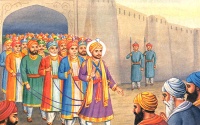
This year (2014) on October 23,(next year its November, 11) the worldwide Sikh community celebrates the return of the sixth Nanak from detention at Gwalior Fort on the same day in about October/November 1619.
This historic event coincides with the Hindu festival of Diwali. This has resulted in similarity of celebration amongst Sikhs and Hindus.
When Murtaja Khan, Nawab of Lahore, noticed that Guru Ji had constructed Sri Akal Takhat Sahib, 'The Throne of the Almighty', at Amritsar, and was also strengthening his army, he informed the Mughal Emperor Jahangir about this.
He also incorrectly emphasised that the Sikh Guru was making preparations to take revenge for his father's torture and martyrdom. When Jahangir came to know about this he at once sent Wazir Khan and Guncha Beg to Amritsar in order to arrest Guru Hargobind Sahib Ji.
But Wazir Khan who was a well-wisher of the Sikh Guru’s requested the Guru to accompany them to Delhi as Emperor Jahangir wanted to meet him. .....More
view – talk – edit – history
- October 18
Hukam is a Gurmukhi word derived from the Persian "hukm", meaning command or order. Hukam refers to an important fundamental concept in Sikhi.
The adherents of this faith believe in the "Hukam of the Lord" - Guru Nanak, the founder Guru says, "How can one become pure?; how can the veil of illusion be torn away? O Nanak, walk in His Hukam; it is written in your destiny (1)" (SGGS p 1). So walk your life in his Hukam!
Now, what exactly does this word Hukam mean in our daily life?
In Sikhism, this Punjabi word literally means "divine will". A Sikh accepts that everything in the Universe happens according to the Will of an all powerful God, who is referred to as Waheguru. It is by the command of Waheguru that we are born and we die. Without His command ".... even a leaf on the tree would not move" is a common saying in Punjabi. .....More
view – talk – edit – history
- October 19
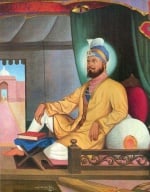
Painting by Amolak Singh.
Guru Har Rai Ji (Gurmukhi: ਗੁਰੂ ਹਰਿ ਰਾਇ) (31 January 1630 - 20 October 1661) was the seventh of the Ten Gurus of Sikhism. Guru ji was the son of Baba Gurdita Ji and Mata Nihal Kaur Ji and the grandson of the sixth Guru, Guru Hargobind. Although, Guru Har Rai Ji was a man of peace, he never disbanded the armed Sikh Warriors (Saint Soldiers), who earlier were maintained by his grandfather, Guru Hargobind.
He always boosted the military spirit of the Sikhs, but he never himself indulged in any direct political and armed controversy with the contemporary Mughal Empire. Once on the request of Dara Shikoh (the eldest son of emperor Shah Jahan), Guru Sahib helped him to escape safely from the bloody hands of Aurangzeb's armed forces during the war of succession.
Guru Sahib also established an Aurvedic herbal medicine hospital and a medical research centre at Kiratpur Sahib. There also he maintained a zoo. Once Dara Shikoh, the eldest son of Shah Jahan fell seriously ill by some unknown disease. The best physicians available in the country and abroad were consulted, but there was no improvement. .....More
view – talk – edit – history
- October 20
In 2015, this week, from October 20, the worldwide Sikh community will celebrate 307 years of Guruship of their holy scriptures called the Sri Guru Granth Sahib.
In October 1708, the tenth and last human Sikh Guru, Guru Gobind Singh before setting off for his heavenly abode, installed the Granth Sahib as the final and perpetual Sikh Guru.
He said "Sabh Sikhan ko hukam hai, Guru maneo Granth" - "Every Sikh is ordered to accept the Granth as the Guru" and so from that day on, this Granth has served as the "living Guru" of the Sikhs.
The Sri Guru Granth Sahib was initially called the Adi Granth and was compiled and first installed at Harimandir Sahib in Amritsar in 1604. The holy book contains hymns written by saints and scholars of different religions and was completed on the 30 August 1604.
The SGGS contains an important message for the whole of humanity. The Guru Granth Sahib provides unique and unequalled guidance and advice for the whole of the human race. It is the torch that will lead humanity out of Kaljug, (the dark era) to a life in peace, tranquillity and spiritual enlightenment for all the nations of the World. .....More
view – talk – edit – history
- October 21
Guru Gobind Singh ji (Gurmukhi: ਗਰੂ ਗੋਬਿੰਦ ਸਿੰਘ) (Friday, January 5, 16661, in Patna, Bihar, India - Thursday, 21 October, 1708) was the tenth and last of the Ten human form Gurus of Sikhism. He became Guru on November 11, 1675 at the age of nine, following in the footsteps of his father Guru Teg Bahadur ji.
Guru Ji was born on January 5, 1666 and moulded the Sikh religion into its present form with the formation of the Khalsa in 1699. The tenth Guru (teacher) of the Sikh faith, was born Gobind Rai. It may not be out of the way to say here that throughout the annals of human history, there was no other individual who could be of more inspiring personality than Guru Gobind Singh.
Guru Ji infused the spirit of both sainthood and solider in the minds and hearts of his followers to fight oppression and support righteousness (Dharma) in order to restore justice, peace and to uplift the down-trodden people in this world. In the short 42 year of life and a Guruship of only 33 years, the Guru contributed immensely to Sikhism and to the world and his gift to all the peoples of the world still remains unmatched to this day. .....More
view – talk – edit – history
- October 22
Guru Har Krishan (Gurmukhi: ਗੁਰੂ ਹਰਿ ਕ੍ਰਿਸ਼ਨ) (Wednesday, 23 July 1656 - Saturday, 16 April 1664) was the eighth of the Ten Gurus of Sikhism.
Guru ji was born at Kiratpur Sahib, Punjab, India and was the second son of Guru Har Rai and Mata Krishan Kaur. He became Guru on Sunday, 20 October 1661 following in the footsteps of his father, Guru Har Rai Ji.
The Guru is fondly called "Bal Guru" ("Child Guru") as he attained Guruship at a young age of just over 5 years old.
Guru sahib caused the illiterate water-carrier named Chhaju Ram to expound the philosophy of the holy Gita on the challenge from Pandit Lal Chand. On hearing this narration of the holy Gita, Pandit Lal Chand was deeply humiliated. He was so impressed with this feat performed by the Guru that he became a Sikh and later escorted Guru ji up to Kurukashatra.
When the Guru came to Delhi, he stayed at the bungalow of Raja Jai Singh. There was a severe smallpox epidemic and many thousands of people were dying. By Guru's blessing, the pool at Bangla Sahib, which is built at the site of Raja Jai Singh's bungalow provided cure for thousands of suffering people. .....More
view – talk – edit – history
- October 23
Bhai Kahn Singh, of Nabha (30 August 1861- 24 November 1938), is a celebrated Sikh scholar and encyclopaedia writer, who was born on 30 August 1861 at the village of Sabaz Banera which is about 5 miles from Nabha, in what was then territory of the princely ruler of Patiala. His father was Narain Singh and his mother was Har Kaur.
Bhai sahib did not attend any school or college for formal education as his father arranged for him to study languages including Hindi, Brij Bhasha and Sanskrit and also poetry from Pandits in and around Nabha. So that by the age of 10, Bhai sahib could recite freely both the Guru Granth Sahib and the Dasam Granth.
Of the many literary works among Bhai Kahn Singh's collection, Gurushabad Ratandkar Mahan Kosh (1930), an encyclopaedia of Sikh literature, will remain a permanent monument to his unmatched excellence, industry and erudition.
This Punjabi language encyclopedia is not only the first dictionary of Sikh Scriptures and books on Sikh Religion .....More
view – talk – edit – history
- October 24
Akal Ustat is the name given to the second Bani in the second holy scriptures of the Sikhs called the Dasam Granth. This text spans from page 33 to page 94 of the 2326 pages of this holy book of the Sikhs at www.sridasam.org. (Original text is printed over 1428 pages). It is composed of 271 verses, and is largely devotional in nature.
The word "Akal" mean the "timeless primal being" and the word "Ustat" means "praise". So together the words "Akal Ustat" means the "praise of the Almighty God". Guru Gobind Singh, the tenth Sikh Guru writes praises of God with love and dedication saying that God is worshipped by various peoples in many different ways and with varying names and methods.
In the Akal Ustat, the Guru describes the Almighty God in all His glory by making use of metaphysical references and the masterful use of imaginative language and image creating phrases. .....More
view – talk – edit – history
- October 25
What influence does the company that we keep have on us? According to the Guru Granth Sahib, the company that we keep has a marked influence on us resulting in disastrous consequences if we are not careful. "Kabeer, I have been ruined and destroyed by bad company" (SGGS p 1369). Bhagat Kabir tells us frankly how his life was destroyed due to the companionship of bad sangat.
Gurbani warns us that through our relationship with others around us we ourselves change. We all know the saying "A person is the product of his or her environment." The Sri Guru Granth Sahib reveals to us that our friendships and the sangat (company) that we keep has a profound influence on our outlook, the way we act, the way we behave and our future development.
The Guru says: "False is friendship with the false and greedy. False is its foundation" (SGGS p 1412). The message again is clear; friendship with a fool, a untruthful person,.... .....More
view – talk – edit – history
- October 26
The Sukhmani sahib is probably the greatest composition of the fifth Sikh Guru, Guru Arjan.
This Gurbani in raga Gauri Sukhmani in the Guru Granth Sahib is a lengthy composition which spans a total of 35 pages from page 262 to page 296 of the sacred Granth.
Its lyrical beauty apart, Sukhmani is a profoundly significant scriptural text for all devotees of the Sikh faith and indeed for all of humanity.
It is said that the Guru wrote it in response to request from a devotee who was suffering from physical pain and mental anguish; the recital of Sukhmani restored him to good health and a calm and peaceful state of mind. The word 'Sukhmani' means the "psalm of equipoise" (balanced state) or "jewel of bliss". This holy bani (hymn) is a treasure of the rarest kind and will bring pure happiness and true bliss for whoever recites it with dedication.
This unique prayer which, not only can be read just as any other bani but can also be sung with music accompaniment has only one focus - to bring "Sukh" or peace to the person’s mind. .....More
view – talk – edit – history
- October 27
In the invocation to Japji Sahib, Guru Nanak provides us with a working definition of the Creator, in mystical but precise terminology -
"Ik-Oamkâr Satinam(u) Karta Purakh Nirbhau Nirvair Akâl-murat(i) Ajuni Saibhan Gur-prasâd(i)".
There is only one Creator, His existence is a reality, He is the only Creator, without fear or rancour, he is beyond death or birth, by himself is he luminous.
By studying Guru Granth Sahib, a Sikh learns that the Creator is Infinite, but HIS presence in His creation can be experienced with a disciplined state of mind. Satguru (the "True spiritual master") guides the Sikhs to experience HIM within.
For this, one needs to be ready to overcome all negative (primal) forces known as ego, anger, lust, deep attachment and greed, which trigger continuous ups and downs in the human mind.
In Gurbani, nothing is as important as the love developed for the Creator.... .....More
view – talk – edit – history
- October 28
Professor Sahib Singh (16 February, 1892 - 29 October 1977) was a renowned Sikh academic who made a tremendous contribution to Sikh literature.
He was an exceptional grammarian, author, scholar and theologian born in a Hindu family in the village of Phattevali in Sialkot district of undivided Punjab.
He was named "Natthu Ram" by his father, Hiranand, who kept a small shop in the village. Soon the family shifted to Tharpal, another nearby village in the same district.
As a youth, Natthu Ram was apprenticed to the village Maulawi (Muslim teacher), Hayat Shah, son of the famous Punjabi poet, Hasham, upon whom his royal patron, Ranjit Singh, the Maharaja of the Punjab, had settled a permanent jagir.
Winning a scholarship at his middle standard examination, Natthu Ram joined the high school at Pasrur. It was here that he decided to become a Sikh and received in 1906 the rites of the Khalsa. Upon joining the Khalsa panth, his new name was Sahib Singh.
The untimely death of his father made the situation hard for him, yet he managed to plough through first Dyal Singh College, Lahore, and then the Government College, Lahore. .....More
view – talk – edit – history
- October 29
Bhagat Namdev ji (29 October, 1270 - 1350) (Gurmukhi: ਭਗਤ ਨਾਮਦੇਵ) was born on October 29, 1270 in the state of Maharashtra village of Naras-Vamani, in Satara district (presently called Narsi Namdev). His father, a calico printer/tailor, was named Damshet and his mother's name was Gonabai.
Most of the spiritual message of Bhagat Namdev, just like our gurus', emphasized the importance of living the life of a householder (grist jeevan) and that through marriage and having a family one could attain enlightenment. He emphasized that the truest form of bandage or devotional meditation, is to enter matrimony and jointly seek the holy experience Waheguru.
Namdev was married before he was eleven years of age to Rajabal, daughter of Govinda Sheti Sadavarte. They had four sons and one daughter. Janabai, the family's maidservant and a bhagat and poetess in her own right, records the tradition that Namdev was born to Gonabai as a result of her worship of Vitthala in Pandharpur. This present temple building was constructed by Sardar Jassa Singh Ramgarhia and the tank by its side was repaired by Rani Sada Kaur, mother-in-law of Maharaja Ranjit Singh. .....More
view – talk – edit – history
- October 30
Once a king in India went to Guru Nanak Dev Ji and asked: "O Guru! As you told us, God Himself supports His true worshipper, but God has so many apostles, why does He support Himself? Why does He not send His apostles to help the worshipper?"
As he said this, his own son who was playing on the bank of a river nearby slipped into the river. The king did not wait for a second and jumped in the river as well to save his child.
After saving his child he returned to the Guru. The Guru asked: "My dear friend, you were sitting here with me a minute ago and why did you jump in the river?"
The king explained that his son had slipped into the river and he went to save him.
Then the Guru asked: "Dear friend, you have so many servants, why did you jump in the river yourself? Why did not you send your servants to save him?" .....More
view – talk – edit – history
- October 31
Gurdwara Patti Sahib also called Gurdwara Maulvi Patti Sahib (‘Patti’ (Gurmukhi: ਪਟੀ) is a Gurmukhi word meaning ‘alphabet’) is built at the site where Guru Nanak at a young age learned the various different languages then used in the Punjab, each with its own distinct alphabet.
This shrine lies midway between Gurdwara Janam Asthan and Gurdwara Bal Lilah along the road leading from Janam Asthan to the railway station in Nankana Sahib. The city has been renamed after its most famous native son Guru Nanak Dev ji. Once known as the village of Talwandi the town is located in West Punjab, Pakistan.
Born on the 15th of April 1469. Nanak was named after his elder sister Nanaki who was named so because of her being born at the house of her "Nana" (maternal granddad or grandfather on mother's side) in the village of Dera Chahal in Lahore district.
As a young child Guru Nanak first studied Punjabi with Pandit Gopal, then Sanskrit with Pandit Brij Lal and at 13 years of age he mastered Persian studying with Maulvi Kutab Ud Din. Hence Patti Sahib is also known as Gurdwara Maulvi Patti Sahib. .....More
view – talk – edit – history
